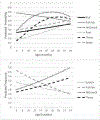Normative Trends in Physically Aggressive Behavior: Age-Aggression Curves from 6 to 24 Months
- PMID: 30429080
- PMCID: PMC7670848
- DOI: 10.1016/j.jpeds.2018.10.025
Normative Trends in Physically Aggressive Behavior: Age-Aggression Curves from 6 to 24 Months
Abstract
Objective: To investigate age-related trends in physically aggressive behaviors in children before age 2 years.
Study design: A normative US sample of 477 mothers of 6- to 24-month-old children reported on the frequency of 9 interpersonally directed aggressive child behaviors, and hurting animals, in the past month.
Results: Almost all (94%) of the children were reported to have engaged in physically aggressive behavior in the past month. Based on 2-part regression models, the prevalences of kicking (OR, 1.70; P = .023), pushing (OR, 3.22; P < .001), and swiping (OR, 1.78; P = .018) increased with years of age, but the prevalence of hair pulling decreased with age (OR, 0.55; P = .020). The prevalences of hitting and throwing increased initially, then plateaued at age 18-20 months, and then decreased (quadratic aOR, 0.13 and 0.16; P < .001 and .010, respectively). The frequencies of hitting (R2 = .05; P < .001) and throwing (R2 = .03; P = .030) increased, and the frequencies of hair pulling (R2 = .07; P < .001) and scratching (R2 = .02; P = .042) decreased with age (P values adjusted for false discovery rate).
Conclusions: Physically aggressive behavior in the 6- to 24-month age range appears to be nearly ubiquitous. Most, but not all, forms of physical aggression increase with age. These results can guide pediatricians as they educate and counsel parents about their child's behavior in the first 2 years of life.
Keywords: aggression; child behavior; child development; infancy; toddlerhood.
Copyright © 2018 Elsevier Inc. All rights reserved.
Figures

Similar articles
-
The development of individual physically aggressive behaviors from infancy to toddlerhood.Dev Psychol. 2018 Apr;54(4):601-612. doi: 10.1037/dev0000450. Epub 2017 Nov 20. Dev Psychol. 2018. PMID: 29154658
-
Is the Use of Physical Discipline Associated with Aggressive Behaviors in Young Children?Acad Pediatr. 2017 Jan-Feb;17(1):34-44. doi: 10.1016/j.acap.2016.02.014. Epub 2016 Feb 26. Acad Pediatr. 2017. PMID: 26924534 Free PMC article.
-
The early childhood aggression curve: development of physical aggression in 10- to 50-month-old children.Child Dev. 2006 Jul-Aug;77(4):954-66. doi: 10.1111/j.1467-8624.2006.00912.x. Child Dev. 2006. PMID: 16942499
-
Normative development of physical aggression from 8 to 26 months.Dev Psychol. 2014 Jun;50(6):1710-20. doi: 10.1037/a0036324. Epub 2014 Apr 7. Dev Psychol. 2014. PMID: 24708457
-
Age differences in the prevalence of physical aggression among 5-11-year-old Canadian boys and girls.Aggress Behav. 2007 Jan-Feb;33(1):26-37. doi: 10.1002/ab.20164. Aggress Behav. 2007. PMID: 17441003
Cited by
-
Potential Moderators of the Association between Parental Psychological Distress and Perceived Child Externalizing Behaviors.Early Child Res Q. 2025 3rd Quarter;72:229-237. doi: 10.1016/j.ecresq.2025.03.007. Epub 2025 Apr 10. Early Child Res Q. 2025. PMID: 40321466
-
Modeling trajectories of physical aggression from infancy to pre-school age, their early predictors, and school-age outcomes.PLoS One. 2024 Jun 3;19(6):e0291704. doi: 10.1371/journal.pone.0291704. eCollection 2024. PLoS One. 2024. PMID: 38829864 Free PMC article.
-
Fetal Frontolimbic Connectivity Prospectively Associates With Aggression in Toddlers.Biol Psychiatry Glob Open Sci. 2022 Sep 21;3(4):969-978. doi: 10.1016/j.bpsgos.2022.09.003. eCollection 2023 Oct. Biol Psychiatry Glob Open Sci. 2022. PMID: 37881555 Free PMC article.
-
Male and female mice display consistent lifelong ability to address potential life-threatening cues using different post-threat coping strategies.BMC Biol. 2022 Dec 15;20(1):281. doi: 10.1186/s12915-022-01486-x. BMC Biol. 2022. PMID: 36522765 Free PMC article.
References
-
- Côté SM, Vaillancourt T, Leblanc JC, Nagin DS, Tremblay RE. The development of physical aggression from toddlerhood to pre-adolescence: a nationwide longitudinal study of Canadian children. J Abnorm Child Psychol. 2006;34:71–85. - PubMed
-
- Côté SM, Vaillancourt T, Barker ED, Nagin D, Tremblay RE. The joint development of physical and indirect aggression: Predictors of continuity and change during childhood. Dev Psychopathol. 2007;19:37–55. - PubMed
-
- NICHD Early Child Care Research Network. Trajectories of physical aggression from toddlerhood to middle childhood: predictors, correlates, and outcomes. Monogr Soc Res Child Dev. 2004;69:1–129. - PubMed
-
- Alink LR, Mesman J, Van Zeijl J, et al. The early childhood aggression curve: development of physical aggression in 10- to 50-month-old children. Child Dev. 2006;77:954–66. - PubMed
-
- Hay DF, Perra O, Hudson K, et al. Identifying early signs of aggression: psychometric properties of the Cardiff Infant Contentiousness Scale. Aggress Behav. 2010;36:351–7. - PubMed
Publication types
MeSH terms
Grants and funding
LinkOut - more resources
Full Text Sources
Miscellaneous

